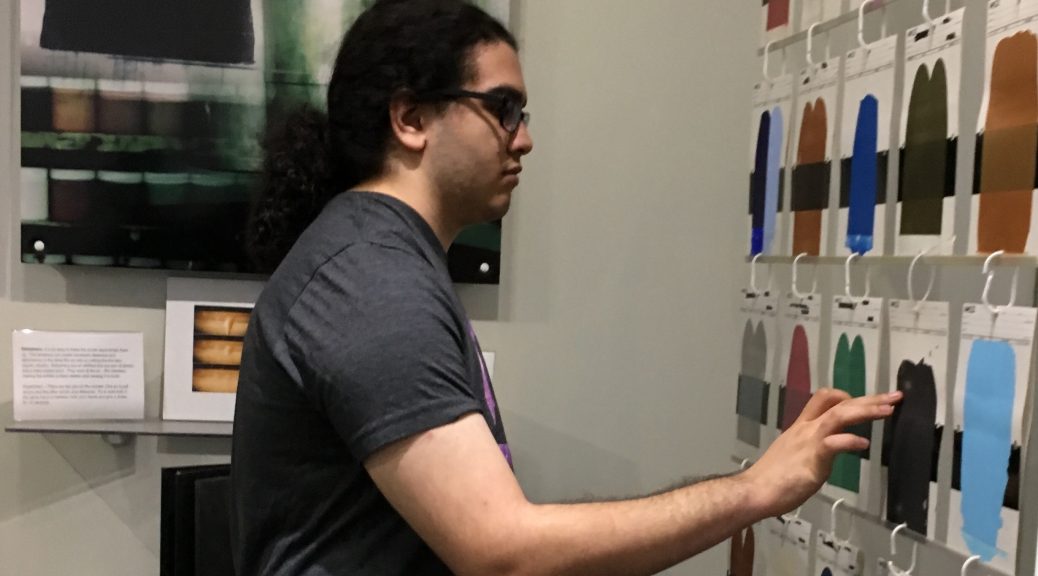Because human culture has a material element, the material world offers an important connection between the arts and humanities and STEM fields. This connection fuels Binghamton University’s new transdisciplinary research group: Material and Visual Worlds. Materials are part of everyday life, yet their physical properties, social histories, and conditions of formation are opaque to most of us. And academics rarely study these varied aspects of materials in concert. With support of a Humanities Connections grant from the National Endowment of the Humanities, we at Binghamton are creating a suite of undergraduate research and general education courses to connect the humanities with STEM fields focused on materials.
The project
Our team includes a cultural anthropologist, a classical archeologist, a graphic designer, a physicist, an engineer, and me (as Director of Undergraduate Research and an interdisciplinary scholar). We are creating spaces where students can consider innovations in the development and use of materials as products not only of elemental processes and scientific experimentation but also of human needs and desires, and of historical forces.
After one year of planning, we developed a pilot course, Materials Matter, that was team taught in Spring 2018 by a humanist (Roman archeologist Hilary Becker) and a scientist (physicist Todd Rutkowski). The course focused on one material: pigments. It taught foundational concepts of the physics of light and color and technical methods of analysis, as well as analytic methodologies of the humanities. These methods included interpretations of textual and artifactual evidence, and theorized understandings of relationships between people and the material assemblages with which they are enmeshed. Students applied scientific tools like X-ray fluorescence to the study of pigments used in ancient and modern times. They also practiced techniques of fresco painting and mixing pigments with different binders by hand, comparing their characteristics. Later, they visited our project partner, Golden Artists Paints in New Berlin, New York, and learned how scientists and artists work together to develop new paint formulations. Their experiences reveal how transdisciplinary study is not just a luxury of the academy but also a wider key to innovation.
Challenges
While students loved our pilot course, we are still refining our approach. From the outset, we wanted to have students analyze glass and ceramic materials as well as pigments. We also want to scale up the 20 seat seminar to a large lecture hall style sectionalized course to provide more students with this experience. But we don’t want to sacrifice the experiential nature of the course activities or the assignments that allow students to formulate and investigate their own questions. An undertaking of this scale has taken a massive orchestration, and our university structures don’t always make it easy. For example, how do we support the instructional expertise we need to teach science and humanities rigorously in one course? How do we support TAs from each area to lead discussion sections and labs? And how do we catalogue such an integrated course in our bulletin?
Development
Dr. Pamela Smart, my colleague on this project, has led the second iteration of Materials Matter. For the first time at Binghamton, we have created a course designated as both laboratory science and aesthetics general education. To support the course, we have assigned one TA from art history and one from chemistry to lead separate sections. Using our NEH award, we hired a a post-doctoral student to formulate and test each lab exercise. We’ll also be inviting guest lecturers to contribute their expertise. Golden Artists Colors will again contribute to the course, and we are bringing in our second industry partner, Corning Museum of Glass. Students will work on a lab custom designed by their chief scientist Jane Cook and curator Marvin Bolt, and then take a field trip to the museum. We will also carefully assess our course through pre- and post-course surveys and focus groups of students and faculty.
Future plans
Ultimately, we want to show undergraduates how to combine research techniques and perspectives from the humanities with those of the sciences. The next planned course will be a first-year research immersion experience, a two-course sequence that will be part of Binghamton’s new initiative, the Source Project. This initiative teaches first-year students how to do research in humanities and social sciences. It also offers courses like Materials Matter which bring these fields into mutually enhancing conversation with STEM fields. For example, a first-year student from the Spring 2018 course chose to ask why red ochre was used as an adulterant with cinnabar in wall paintings in Roman villas. He answered the question by considering cinnabar’s chemical as well as economic properties. Asked to reflect on his experience doing this work he concludes, “By combining the humanities and sciences, I was able to ask unique questions, go further in-depth, and expand more than I would have been able to otherwise. The humanities and sciences need each other in order to tell a complete story.”
Implications
The challenges we face in integrating STEM and humanities have implications not only for teaching and learning but also for the ways we go about organizing research. Over the past two years we have seen how the intellectual labor of our team has spurred new relationships and integrative research projects for faculty and staff. And we are pleased that our first doctoral student assistant received a post-doc position to work on a new interdisciplinary curriculum at another public university. This project has deepened our conviction that the most compelling and productive way to foster a liberal education is through integrative, experiential coursework that goes beyond the boundaries of any one discipline. If you’d like to hear more, we will be presenting our work in a panel at the AAC&U annual conference later this month with other like-minded colleagues creating similar experimental courses at their institutions.

